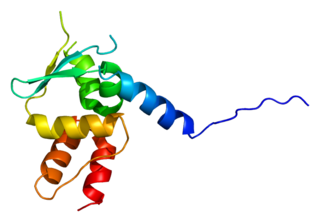
Cathepsin A is an enzyme that is classified both as a cathepsin and a carboxypeptidase. In humans, it is encoded by the CTSA gene.

Aristaless related homeobox is a protein that in humans is encoded by the ARX gene.

Fukutin is a eukaryotic protein necessary for the maintenance of muscle integrity, cortical histogenesis, and normal ocular development. Mutations in the fukutin gene have been shown to result in Fukuyama congenital muscular dystrophy (FCMD) characterised by brain malformation - one of the most common autosomal-recessive disorders in Japan. In humans this protein is encoded by the FCMD gene, located on chromosome 9q31. Human fukutin exhibits a length of 461 amino acids and a predicted molecular mass of 53.7 kDa.

The human gene SPAST codes for the microtubule-severing protein of the same name, commonly known as spastin.

Glycine decarboxylase also known as glycine cleavage system P protein or glycine dehydrogenase is an enzyme that in humans is encoded by the GLDC gene.

Torsin-1A (TorA) also known as dystonia 1 protein (DYT1) is a protein that in humans is encoded by the TOR1A gene. TorA localizes to the endoplasmic reticulum and contiguous perinuclear space, where its ATPase activity is activated by either LULL1 or LAP1, respectively.

Cystatin-B is a protein that in humans is encoded by the CSTB gene.

Aprataxin is a protein that in humans is encoded by the APTX gene.

Acetylcholine receptor subunit epsilon is a protein that in humans is encoded by the CHRNE gene.

Beta-sarcoglycan is a protein that in humans is encoded by the SGCB gene.

Translation initiation factor eIF-2B subunit delta is a protein that in humans is encoded by the EIF2B4 gene.

Translation initiation factor eIF-2B subunit gamma is a protein that in humans is encoded by the EIF2B3 gene.

Gamma-sarcoglycan is a protein that in humans is encoded by the SGCG gene. The α to δ-sarcoglycans are expressed predominantly (β) or exclusively in striated muscle. A mutation in any of the sarcoglycan genes may lead to a secondary deficiency of the other sarcoglycan proteins, presumably due to destabilisation of the sarcoglycan complex. The disease-causing mutations in the α to δ genes cause disruptions within the dystrophin-associated protein (DAP) complex in the muscle cell membrane. The transmembrane components of the DAP complex link the cytoskeleton to the extracellular matrix in adult muscle fibres, and are essential for the preservation of the integrity of the muscle cell membrane.

Hermansky–Pudlak syndrome 1 protein is a protein that in humans is encoded by the HPS1 gene.

Periaxin is a protein that in humans is encoded by the PRX gene.

EF-hand domain-containing protein 1 is a protein that in humans is encoded by the EFHC1 gene.

Gigaxonin also known as kelch-like protein 16 is a protein that in humans is encoded by the GAN gene.

NHL repeat-containing protein 1 is a protein that in humans is encoded by the NHLRC1 gene.
Myoclonic dystonia or Myoclonus dystonia syndrome is a rare movement disorder that induces spontaneous muscle contraction causing abnormal posture. The prevalence of myoclonus dystonia has not been reported, however, this disorder falls under the umbrella of movement disorders which affect thousands worldwide. Myoclonus dystonia results from mutations in the SGCE gene coding for an integral membrane protein found in both neurons and muscle fibers. Those suffering from this disease exhibit symptoms of rapid, jerky movements of the upper limbs (myoclonus), as well as distortion of the body's orientation due to simultaneous activation of agonist and antagonist muscles (dystonia).

Gap junction delta-2 protein (GJD2), also known as connexin-36 (Cx36) or gap junction alpha-9 protein (GJA9), is a protein that in humans is encoded by the GJD2 gene.



















